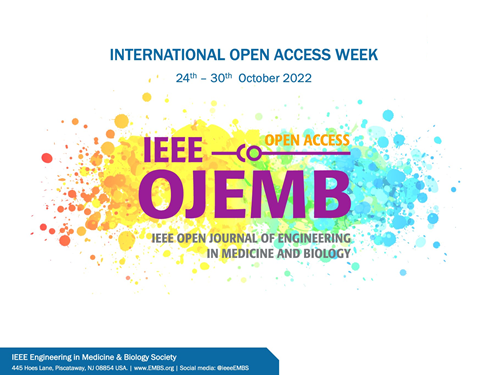利用数字孪生计算模型模拟图像引导的微波消融疗法
IF 2.7
Q3 ENGINEERING, BIOMEDICAL
IEEE Open Journal of Engineering in Medicine and Biology
Pub Date : 2023-12-27
DOI:10.1109/OJEMB.2023.3345733
引用次数: 0
摘要
新兴的计算工具,如医疗数字孪生建模,能够制定针对患者的手术计划,包括治疗原发性和继发性肝癌的微波消融术。医疗数字孪生(DTs)是根据结构、功能和生物标志物成像数据构建的解剖学一一对应生物物理模型,用于模拟患者特异性疗法并指导临床决策。在微波消融(MWA)中,包括组织灌注、肝脏脂肪变性和纤维化在内的组织特异性因素会影响治疗范围,但目前的热剂量指南并未考虑这些参数。本研究建立了一个磁共振成像框架,用于构建三维生物物理数字双胞胎,以预测在存在肿瘤的情况下,脂肪含量达到 5 级的肝脏的消融输送情况。研究考虑了四种微波天线放置策略,然后使用 915 MHz 和 2450 MHz 天线在五级脂肪肝的肿瘤无知 DT(对照组)和肿瘤知情 DT 中进行了模拟微波消融。在915 MHz和2450 MHz天线模拟的脂肪肝等级范围内,发现脂肪含量会显著增加消融体积,在肿瘤未受影响的DT中约增加29-l42%,在肿瘤知情的DT中约增加55-60%。在 915 MHz 模拟中,肿瘤的存在对同一脂肪变性等级的消融量没有明显影响,但在 2450 MHz 模拟中,对轻度、中度和高脂脂肪变性等级的消融量有明显增加。对置放策略的签名一致距离进行的分析表明,考虑患者特定的肿瘤组织特性对术前评估消融区覆盖范围的消融预测有重大影响。本文章由计算机程序翻译,如有差异,请以英文原文为准。
Simulation of Image-Guided Microwave Ablation Therapy Using a Digital Twin Computational Model
Emerging computational tools such as healthcare digital twin modeling are enabling the creation of patient-specific surgical planning, including microwave ablation to treat primary and secondary liver cancers. Healthcare digital twins (DTs) are anatomically one-to-one biophysical models constructed from structural, functional, and biomarker-based imaging data to simulate patient-specific therapies and guide clinical decision-making. In microwave ablation (MWA), tissue-specific factors including tissue perfusion, hepatic steatosis, and fibrosis affect therapeutic extent, but current thermal dosing guidelines do not account for these parameters. This study establishes an MR imaging framework to construct three-dimensional biophysical digital twins to predict ablation delivery in livers with 5 levels of fat content in the presence of a tumor. Four microwave antenna placement strategies were considered, and simulated microwave ablations were then performed using 915 MHz and 2450 MHz antennae in
Tumor Naïve DTs
(control), and
Tumor Informed DTs
at five grades of steatosis. Across the range of fatty liver steatosis grades, fat content was found to significantly increase ablation volumes by approximately 29–l42% in the Tumor Naïve and 55–60% in the
Tumor Informed DTs
in 915 MHz and 2450 MHz antenna simulations. The presence of tumor did not significantly affect ablation volumes within the same steatosis grade in 915 MHz simulations, but did significantly increase ablation volumes within mild-, moderate-, and high-fat steatosis grades in 2450 MHz simulations. An analysis of signed distance to agreement for placement strategies suggests that accounting for patient-specific tumor tissue properties significantly impacts ablation forecasting for the preoperative evaluation of ablation zone coverage.
求助全文
通过发布文献求助,成功后即可免费获取论文全文。
去求助
来源期刊

IEEE Open Journal of Engineering in Medicine and Biology
ENGINEERING, BIOMEDICAL-
CiteScore
9.50
自引率
3.40%
发文量
20
审稿时长
10 weeks
期刊介绍:
The IEEE Open Journal of Engineering in Medicine and Biology (IEEE OJEMB) is dedicated to serving the community of innovators in medicine, technology, and the sciences, with the core goal of advancing the highest-quality interdisciplinary research between these disciplines. The journal firmly believes that the future of medicine depends on close collaboration between biology and technology, and that fostering interaction between these fields is an important way to advance key discoveries that can improve clinical care.IEEE OJEMB is a gold open access journal in which the authors retain the copyright to their papers and readers have free access to the full text and PDFs on the IEEE Xplore® Digital Library. However, authors are required to pay an article processing fee at the time their paper is accepted for publication, using to cover the cost of publication.
 求助内容:
求助内容: 应助结果提醒方式:
应助结果提醒方式:


